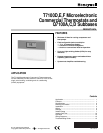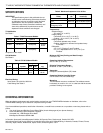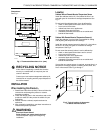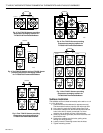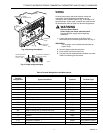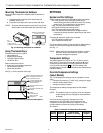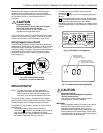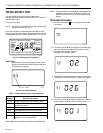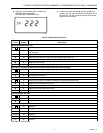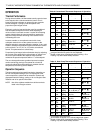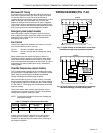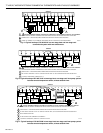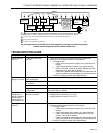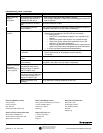
T7100D,E,F MICROELECTRONIC COMMERCIAL THERMOSTATS AND Q7100A,C,D SUBBASES
68-0163—3 12
Selection
Fan System Call Energize Display
Auto
Off None None None
On Off None G
Auto Cool None O None
Auto Cool or
Auto
Stage 1
Cooling
O, G and Y or O,
G and Y1
and
Auto Cool or
Auto
Stage 2
Cooling
O, G and Y2
and
Auto Heat None B None
Auto Heat or
Auto
Stage 1
heating
B and W
a
or
B
and
W1
a
and
Auto Heat or
Auto
Stage 2
heating
B and W2
a
and
Auto Auto None
O or B
b
None
Selection
Fan System Call Energize Display
Auto
Off None None None
On Off None G
Auto Cool None O None
Auto Cool or
Auto
Stage 1
Cooling
O, G and Y, or O,
G and Y1
and
Auto Cool or
Auto
Stage 2
Cooling
O, G and Y2
and
Auto Heat None B None
Auto Heat or
Auto
Stage 1
heating
B and W, B
and
W1, or B and Y1
a
and
Auto Heat or
Auto
Stage 2
heating
B and W2, or B
and Y2
a
,
,
and Aux Ht
b
Auto Heat or
Auto
Stage 3
heating
B, Y1, Y2
and W3
,
,
and Aux Ht
Auto Em
Heat
None B and X1 Em Ht
Auto Em
Heat
Stage 1
heating
B, X1 and E
,
,
and Em Ht
Auto Em
Heat
Stage 2
heating
B, X1, E
and W2
,
, Em Ht
and Aux Ht
Auto Auto None
O or B
c
None
OPERATION
Thermal Performance
During severe weather, the thermostat actually controls closer
to the setpoint than a electromechanical control. This is
because the heat anticipator is replaced by two electronic
control strategies—cycling by heat anticipation and
proportional plus integral control.
Electronic cycling by heat anticipation acts like a traditional
heat anticipator except that it never needs adjusting for
various control circuit load currents. It cycles off the heating
system slightly before the room temperature reaches the
setpoint to keep the heat remaining in the ductwork from
overheating the room.
In severe weather, a conventional control with a heat
anticipator tends to turn off the system too soon so the
effective setpoint is somewhat below the setpoint. In very cold
weather, the difference between setpoint and effective control
point can be 5°F or 6°F (2°C or 3°C) with a conventional
control. This phenomenon is called
droop
.
Proportional plus integral action eliminates droop by adjusting
the on time of the stage that is cycling longer or shorter until
the control point matches the setpoint. The thermostat
maintains the space temperature within 1°F of the setpoint.
The
zero droop
performance provides improved occupant
comfort and energy savings. Occupants do not need to
continually adjust thermostat settings to maintain desired
temperature, even during severe weather.
Operation Sequence
The thermostat energizes specific terminals, depending on
the Fan and System settings. The LCD displays the time,
room temperature, system and fan selection. Symbols are
displayed when the heating, cooling or fan is energized. See
Tables 9 and 10 for specific information.
NOTE: Not all the subbase models have all the terminals
listed in the Energize column.
Table 9. Conventional Thermostat Sequence of Operation.
a
When Installer Setup 02 is set to 01 (electric heat), G is
energized and the fan symbol is also displayed.
b
Based on last piece of equipment called (cooling = O or
heating = B) and Installer Setup selection.
Table 10. Heat Pump Thermostat Sequence of Operation.
a
Three-stage heat model only.
b
Aux Ht does not appear if it is a three-stage heat system.
c
Based on last piece of equipment called (cooling = O or
heating = B) and Installer Setup selection.



